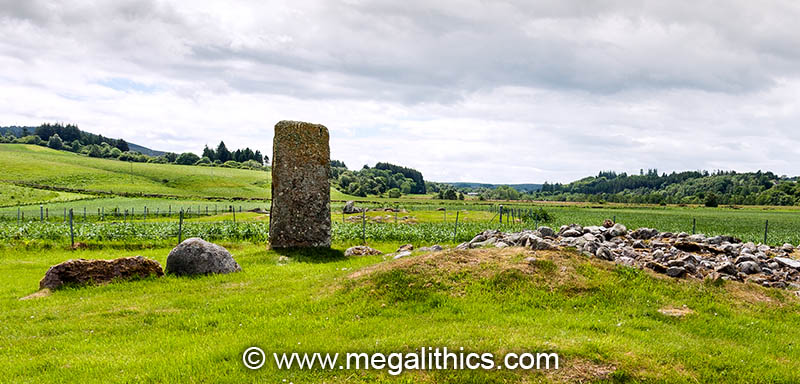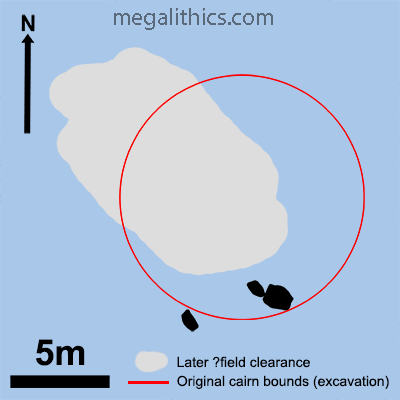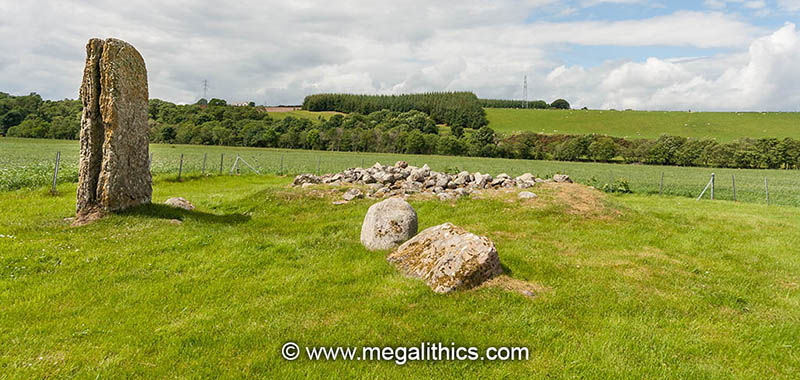 |
| NH 75252 43963 (GPS 10min) Centre. | Diameter n/a |
| Visited June 2010 | Alt.117m OD (GPS) |
 |
Miltown of Clava North ( INV 43 ), is probably a Clava cairn, but even after partial excavation, its true nature remains unknown. It is located in the valley of the River Nairn only 600m SW of the famous Balnuaran of Clava cemetery.

There is some confusion in the literature regarding the nomenclature of this and other sites that exist in close proximity in the Nairn valley. Most of the confusion is caused by Thom's and Burl's description and plan of the Culdoich ring-cairn in their work "Megalithic Rings" (5), which bears the name "Miltown of Clava" as its primary designation. The correct name of "Culdoich" is only mentioned as alternative or secondary name. In these pages we are adhering to the naming scheme found in Henshall's great work (4), and we have produced the following map based on this.

Miltown of Clava is used to describe two sites about 200m
NE of the Culdoich (INV 21) Clava Ring-Cairn and around 600m SW of the Balnuaran of Clava cairn cemetery. The site described here is Miltown of Clava
North (INV 43), The site of Miltown of Clava South (INV 44) is about 70m to
the SW and is thought to have been a Clava monument, but this was completely
destroyed by the building of a chapel on the site, and no trace of the original
monument remains. We hope this clarifies matters.
PUBLISHED ACCOUNTS
Cosmo Innes (1) visited the Milton of Clava sites in 1857, but was unaware that the chapel remains he mentions were built on a probable Clava cairn. He does mention the cairn remains that are Miltown of Clava North, but does not ascribe any name them. He was impressed by "another fine standing stone 9 feet above the ground, and which has apparently been one of a circle, of which the others have fallen". We do wonder if his reference to fallen stones implies that some of these were still extant at the time of his visit.
Jolly (2) describes cairn remains in the area in his account of 1881 "In a field south of; Milton, there exist the remains of another cairn with encircling stones. The outer' circle is represented by only one great block, a handsome angular oblong mass, of yellow sandstone, 7 feet 10 inches high and 3. feet 4 inches wide, which stands quite erect. If any cups ever existed on it, they have been weathered out. There still remain four stones of the middle circle and one of the inner." He also mentions the chapel foundations close by to the south of the remains, so there is little doubt that the remains he describes are those of Miltown of Clava North. It is a little galling however, that he describes what sounds like surviving inner and outer kerb stones as late as 1881, as most of these have disappeared since.
Fraser (3) gives a rather confusing account of what is most likely Miltown of Clava North, "Of the circle itself there remain only one large standing stone and four or five smaller ones." His account is of "Circles Nos. 8 and 9" but his description only seems to refer to one monument, although part of his account could be referring to two standing stones.
Henshall's 1963 magnum opus (4) includes both of the Miltown sites, although the descriptions are brief.
Sharples (6) describes his partial excavation at Miltown of Clava North in 1993, but, although establishing the limits of the original cairn, disappointingly there was not enough evidence to identify exactly what class on monument existed here.
THE CAIRN "STRUCTURE"
There is very little of the original cairn structure visible at the site today. The most striking feature (and the one most commented on by antiquarians) is the large monolith that is the only survivor of the stone circle that presumably surrounded the original cairn. Apart from this there are two reasonably large stones to the ENE of the monolith that look as though they may be original features in situ. Apart from these there is a large roughly rectangular mound of stone rubble roughly 10x6m oriented NW-SE to the North of the remaining stones, this does also seem to overlay a lower, more circular, mound to the SE.
To the South of this site are the rectangular remains of a chapel, which Jolly (2) tells us was "known as St. Bridget's Chapel. The numerous large stones still remaining in connection with this enclosure and its contents would point to the former existence here of another great cairn like the others at Clava". This is the remains of Miltown of Clava South (INV 44), nothing of this cairn can be seen at the site today.

Looking at the site today, it is very tempting to interpret the view above as the central stones being part of the arc of outer kerb stones that would have been surrounded by a stone circle of which the surviving monolith was part. This idea is invalidated by the results of Shaples' (6) partial excavation of the site in 1993. He found the margins of the original cairn which was around 12m in diameter, this is shown as a red ring in our plan of the site above, and although the two smaller stones could just be disturbed outer kerb stones, the position of the monolith does not fit with any Clava cairn layout yet discovered.
Sharples' excavation seemed to raise more questions than it answered. Although the cairn margins were established, there was no trace of the large outer kerb stones that are a characteristic of Clava monuments, similarly, there was no trace of a deliniated internal space, which Clava ring-cairns and passage graves both possess. The most anomalous finding is the very close, and non-tangential, position of the monolith to the cairn circle, no currently known Clava monument has a massive standing stone in a similar position. Sharples speculates that it may have been "re-erected in the wrong place at some time in the unrecorded past", but Innes has it in place in 1857 and previous to this time it was much more likely that stones would be robbed rather than re-erected.
Despite Sharples' investigations it is still not clear exactly what type of cairn is represented here, the positioning of the monolith, the lack of outer kerbs or inner space all pose problems for a fit to a Clava monument. Puzzlingly, although his excavations covered almost a quarter of the cairn periphery, he did not report finding any stone holes, these would be expected if the surviving monolith was indeed part of a stone circle. Shaples' largest trench included part of the SW quadrant of the cairn, but he found no evidence of entrance or passage structures here, which does suggest, if the cairn outline discovered is correct, that this was not a passage grave.
The standing stone alone is very attractive, but given the site's close proximity to the the megalithic feast to be had at Balnuaran, we suspect most folk would be underwhelmed viewing Miltown after a visit to the wonderment there. One for the die-hard megalithic fans only perhaps.
1.
Innes, C.,
Proceedings of the Society of Antiquaries of
Scotland, 3, p.48-9,1857-59.
2. Jolly,
W.,
Proceedings of the Society of Antiquaries of
Scotland, 16, p.321-2,1881-82.
3. Fraser J.,
Proceedings of the Society of Antiquaries of
Scotland, 18, p.341,1884.
4.
Henshall, A. S.,
The Chambered Cairns of Scotland,
p.371-3, Edinburgh University Press, 1963,
Edinburgh.
5.
Thom, A., Thom, A. S. and Burl, A., Megalithic
Rings, B.A.R. British Series, 81, p.248-9, 1980, Oxford.
6.
Sharples, N.M., Glasgow Archaeological Journal,
18, p.1-9. 1993.